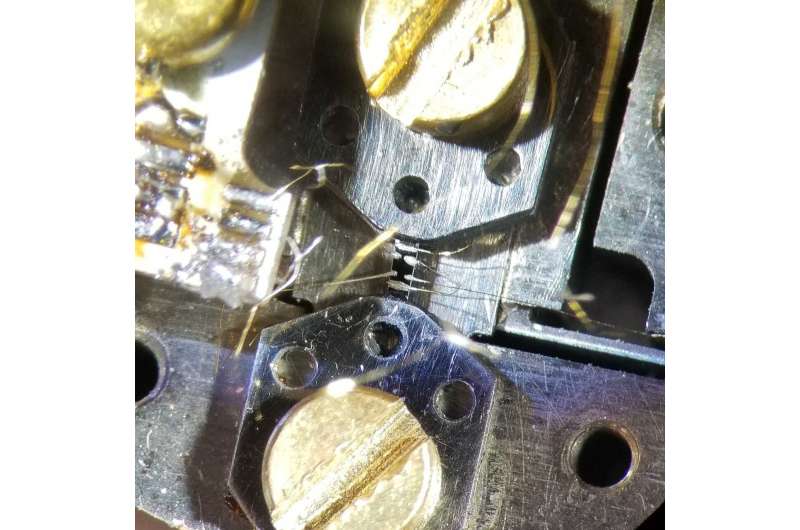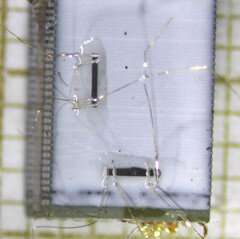January 22, 2020 feature
Study investigates enhancements in the superconductivity of electronic nematic systems

High-temperature superconductors, materials that become superconducting at unusually high temperatures, are key components of a variety of technological tools, including MRI machines and particle accelerators. Recently, physicists have observed that the two families of known high-temperature superconductors—copper- and iron-based compounds—both exhibit a unique phenomenon in which electronic degrees of freedom can break the overall crystal rotational symmetry and form what is known as the electronic nematic phase.
Akin to the liquid crystal phase, the spontaneous breaking of symmetries by electrons is understandable, except for the fact that electrons are not molecules with irregular shapes. In addition, electrons tend to be involved in other properties such as magnetism, so understanding the role of "nematicity" can be quite challenging, since it is often found in coexistence with other orders such as magnetism.
Physicists at the University of Maryland and the University of Illinois-Urbana Champaign, in collaboration with theorists at the University of Minnesota, have recently carried out a study aimed at better understanding the electronic nematic phase in different high-temperature superconductors. Their paper, published in Nature Physics, is based on ideas and observations that they gathered over several years of research.
The same team of researchers started investigating iron-based superconductors approximately 10 years ago. They have since published numerous papers focusing specifically on the electronic nematic phase.
"Some iron superconductors with the same crystal structure arrangement as Ba1−xSrxNi2As2are known to 'collapse' at low temperatures," Dr. Johnpierre Paglione, the lead researcher of the study, told Phys.org. "Intrigued by this observation, we started looking for the same collapsing effect in the nickel-based system by studying its crystal structure at low temperatures. While doing this, we discovered that a completely different phase transition happens, called charge ordering."
In their recent study, the researchers set out to determine whether the charge order that they had previously observed in nickel-based superconductors is also accompanied by the nematic phase. They specifically studied the material Ba1−xSrxNi2As2, which has a structure similar to that of iron-based superconductors.

"We knew that in both 'end-member' compounds BaNi2As2 and SrNi2As2, superconductivity exists at very low temperatures (below 1 Kelvin) and we were very intrigued that it appeared very similar in character in both systems, even if BaNi2As2 has all this crazy physics happening and SrNi2As2 is basically a lemon," Paglione explained. "We thus set about to make alloys of the two, mixing barium and strontium in a systematic way to go from one end to the other in a continuous way."
Interestingly, Paglione and his colleagues observed that when their alloys were somewhere between the barium and strontium compounds (at around 70%Sr) their charge order was completely killed (i.e., suppressed to absolute zero temperature), while their nematic fluctuation signatures remained strong. They also found that at the peak of these fluctuations the material's superconductivity was amplified by a factor of six (i.e., the transition temperature was pumped up from 0.6 K to 3.5 K).
This observation is difficult to explain using conventional theories and of superconductivity and other approaches. They thus concluded that it must be a result of nematic fluctuations.
"Our study has important implications, because we know the tuning knob to do this, and there is no pesky magnetism to complicate the theoretical interpretation, so our interpretation provides a pathway toward fine-tuning materials to get high temperature superconductivity," Dr. Paglione said.
Overall, Paglione and his colleagues observed a direct relationship between enhanced pairing and nematic fluctuations in the model system they examined. In the future, the insight gathered in their study could inform future studies investigating the role of nematicity in strengthening superconductivity.
"We are currently focusing on the hot zone around 70%Sr to see how finely we can tune things using other knobs in the lab, such as pressure and strain," Dr. Paglione said. "At the same time we are searching for other materials that show similar properties and therefore may be artificially tuned to become superconductors as well, hopefully near room temperature."
More information: Chris Eckberg et al. Sixfold enhancement of superconductivity in a tunable electronic nematic system, Nature Physics (2019). DOI: 10.1038/s41567-019-0736-9
Journal information: Nature Physics
© 2020 Science X Network





















